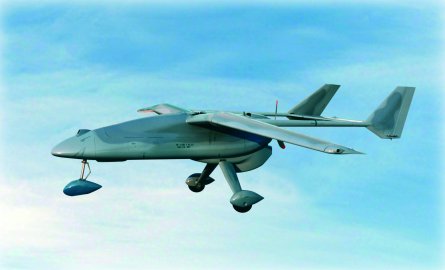By Peter La Franchi in Paris
Italy’s Galileo Avionica has unveiled proposals for an aircraft carrier- or large-deck warship-launched and recovered version of its Falco tactical unmanned air vehicle.
A maritime configuration proto-type will be rolled out within one year, with this to be ready for initial shore-based trials in around two years, says marketing manager Carlo Siardi.
|
|---|
| Falco's short take-off and landing footprint lends itself to maritime work |
The new UAV variant would carry a dual sensor payload comprising an EOST-45 infrared and electro-optical turret and Selex’s new Gabbiano X-band multimode lightweight maritime radar. The latter already supports rotating maritime surveillance and fixed synthetic-aperture radar (SAR) modes, with development of an inverse-SAR capability also planned.
Siardi says the Falco’s existing short take-off and landing footprint of around 60m (195ft) means carrier landings should be feasible with minimal aircraft changes. Galileo Avionica has already undertaken extensive wake turbulence studies of the Italian navy’s current and proposed next-generation aircraft carriers, including windtunnel studies.
The UAV would take off on its own power, with deck landings to require augmentation of the navigation suite and some form of precision approach aid – radar and laser options are being considered. Studies are also underway on whether the UAV could be fitted with the same precision landing system carried by the Italian navy’s Boeing AV-8B Harrier II fighters.
The Falco air vehicle’s existing undercarriage has been designed to support hard landings during emergency parachute recovery operations and should also require few changes, says Siardi.
Testing has already been carried out using hardware simulations to confirm gear loadings and performance during ship deck landings. Conceptual work is being carried out on a possible application of the UAV to extend a carrier’s anti-ship missile defence system by undertaking decoy roles.
Siardi reveals that Galileo Avionica had also won two firm export orders for the basic land surveillance version of the Falco by late May, but declines to provide further details.
Ongoing work to mature the basic Falco system includes fitting a new J-band datalink; integrating electronic intelligence payloads; and studying the potential carriage and deployment of mini-UAVs from hard points on the forward tailbooms.
Meanwhile, Galileo Avionica is seeking approvals from the UK Civil Aviation Authority to participate in the ParcAberporth 2006 UAV demonstration at West Wales airport in early July using the Falco air vehicle.
Source: Flight International
























